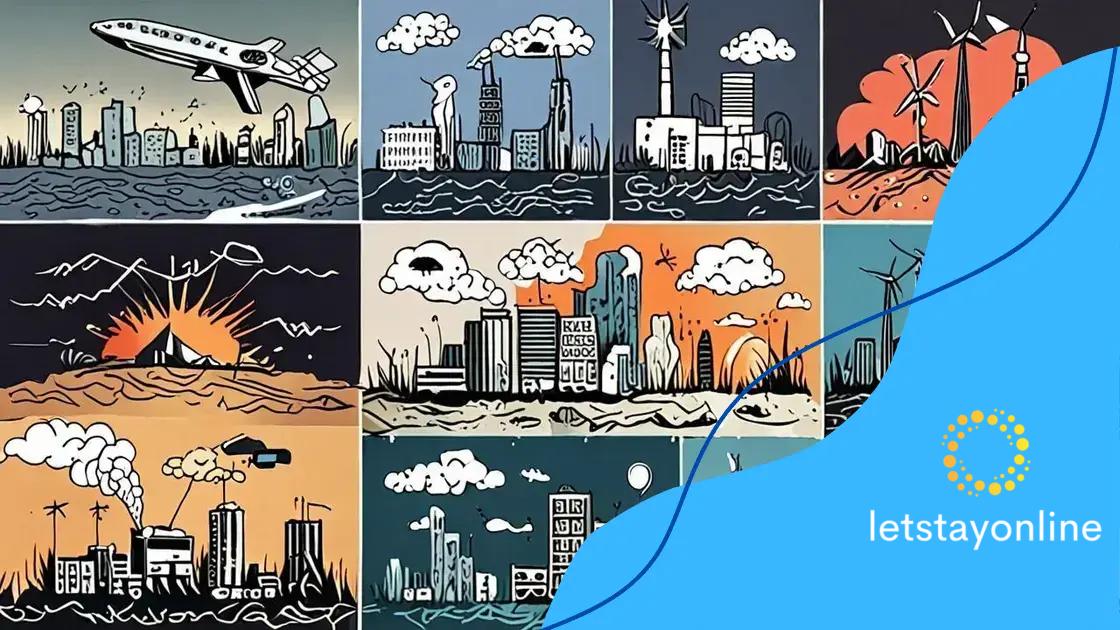The role of AI in predicting natural disasters

The role of AI in predicting natural disasters involves utilizing advanced algorithms to analyze data, enhance forecasting accuracy, and improve response strategies, ultimately improving community safety and disaster preparedness.
The role of AI in predicting natural disasters is gaining traction, with technology evolving to meet urgent challenges. Have you ever wondered how advanced data analysis can save lives? Let’s dive into how AI is reshaping disaster response.
Understanding natural disaster prediction
Understanding the prediction of natural disasters is crucial for saving lives and minimizing damage. With advancing technologies, we can now leverage data to foresee catastrophic events more accurately than ever before.
The importance of predicting natural disasters
When we talk about natural disaster prediction, it refers to the ability to forecast events such as earthquakes, floods, and hurricanes. Early warnings give communities valuable time to prepare and evacuate if necessary. These predictions can significantly reduce risks and enhance safety.
How technology aids in prediction
Technological advancements, particularly with Artificial Intelligence (AI), have transformed how we interpret environmental data. AI algorithms analyze massive datasets from various sources—satellite images, weather patterns, and geological activity—to make precise predictions. This allows for better preparedness and response strategies in affected areas.
- Machine learning enhances data analysis and prediction accuracy.
- Real-time data helps monitor environmental changes.
- Predictive models can simulate disaster scenarios.
By using AI, meteorologists can predict the likelihood of severe weather events with much higher accuracy. This capability can help first responders plan better resource allocation during crises, ultimately saving lives.
Challenges in disaster prediction
Despite technological advancements, there are still challenges related to predicting natural disasters. Data collection can be inconsistent, and the complexity of weather systems means that predictions are not always precise. Additionally, uncertainties can lead to either overstating risks or underestimating potential threats.
There is also the challenge of ensuring that communities receive timely and understandable warnings. In some cases, messages can be lost in translation, leading to confusion and inaction when a disaster looms. To improve these systems, increased public awareness and education are essential.
Ultimately, a combined effort from technology and community preparedness is necessary to enhance natural disaster prediction. Embracing these advancements can lead to better resilience against the unexpected.
How AI algorithms analyze weather patterns
Understanding how AI algorithms analyze weather patterns is key to improving our ability to anticipate natural disasters. By using advanced computing techniques, we can interpret large amounts of data from various sources.
The role of data in AI analysis
Data is the backbone of any AI analysis. For weather patterns, AI relies on data collected from satellites, weather stations, and radar systems. This data includes temperature, humidity, wind speed, and precipitation. By processing this information rapidly, AI can identify trends and anomalies.
- Real-time monitoring allows for immediate data analysis.
- Historical data helps predict future weather conditions.
- Machine learning improves with more data input.
As AI systems gather more data, they become increasingly accurate in their predictions. They learn from previous weather events, adapting their models accordingly. This adaptability makes AI an invaluable tool in forecasting.
Machine learning techniques
AI uses various machine learning techniques to analyze patterns effectively. Supervised learning trains models using labeled datasets, while unsupervised learning finds patterns in unlabeled data. Both methods play crucial roles in developing forecasts.
The complexity of weather systems means that predictions can vary. AI models must handle large datasets, which can include thousands of variables. By using neural networks, AI systems can simulate and understand the interactions within these complex data sets.
Furthermore, collaborative filtering helps AI suggest likely weather scenarios based on similar past events. This capability allows meteorologists to improve their forecasts and provide more reliable information.
As technology advances, the integration of AI algorithms into weather prediction systems continues to evolve. These improvements lead to better preparedness for potential natural disasters, ultimately saving lives and minimizing economic damage.
Case studies of AI in disaster management

Case studies of AI in disaster management show how innovative technology is reshaping our responses to crises. Real-world examples highlight the impact AI can have in mitigating the effects of natural disasters.
AI in Hurricane Prediction
In recent years, AI has been employed to improve hurricane forecasting. For instance, a research team created an AI model that analyzes satellite imagery and meteorological data. This model can predict hurricane paths with increased accuracy, providing essential information to emergency responders.
- Significantly reduces the margin of error in predictions.
- Allows for timely evacuations and resources allocation.
- Helps communities prepare for potential impacts.
As a result, areas better prepared are able to minimize the devastation caused by storms. The use of AI has transformed how we interpret data, leading to faster and more reliable forecasts.
Flood Management Systems
AI also plays a key role in flood management. Cities like Houston have implemented systems that combine sensors, historical data, and real-time information. These systems use AI algorithms to predict flooding events and evaluate risks for different areas.
By analyzing rainfall patterns, soil saturation levels, and river flow, these tools enhance decision-making during emergencies. They enable officials to issue flood warnings well in advance, potentially saving lives and reducing property damage.
Earthquake Early Warning
In Japan, AI is being leveraged to create early warning systems for earthquakes. By analyzing data from seismic activity, AI can detect patterns that may indicate an impending tremor. This information allows for alerts to be sent out seconds before shaking arrives, giving people valuable moments to seek safety.
Such systems show the potential of AI in disaster preparedness by offering timely alerts. Even seconds can make a huge difference during disasters.
These case studies prove that AI technologies not only enhance the accuracy of predictions but also significantly influence how communities respond to natural disasters. As these systems continue to evolve, they can lead to more effective disaster management worldwide.
Challenges in implementing AI technologies
Implementing AI technologies in disaster management is not without its challenges. Understanding these obstacles is crucial for improving the effectiveness of AI applications and maximizing their benefits.
Data Quality and Availability
One of the primary challenges is ensuring the quality and availability of data. AI systems rely on accurate data to make predictions, and poor data can lead to unreliable results. Many regions lack consistent and comprehensive data collection systems.
- Disparate data sources can create inconsistencies.
- Limited historical data hampers machine learning models.
- Inaccessible data due to privacy regulations can limit analysis.
To overcome these challenges, standardizing data formats and improving data collection methods are necessary. Collaborative efforts are needed to share data among organizations and agencies.
Integration with Existing Systems
Integrating AI technologies with existing disaster response systems can be complex. Many organizations have established methods over the years, and adding AI may require significant changes to processes and structures. Resistance from personnel who are accustomed to traditional methods is also a common hurdle.
Training staff on new AI systems is essential to ensure smooth transitions. Effective communication about the benefits of AI can help alleviate concerns and foster acceptance.
Technical Limitations and Costs
The costs associated with implementing AI technologies can be a barrier, especially for smaller organizations or those in developing regions. The required infrastructure, software, and training can strain budgets. Additionally, AI algorithms require significant computational power, which can lead to further costs.
Improving accessibility to AI tools and resources can help mitigate these financial barriers. Leveraging cloud resources and open-source software might provide lower-cost alternatives for organizations aiming to utilize AI.
These challenges highlight the need for strategic planning and collaboration among stakeholders when implementing AI technologies in disaster management. Addressing these issues effectively will enhance the potential of AI to save lives and improve resilience during natural disasters.
The future of AI in enhancing disaster response
The future of AI in enhancing disaster response looks promising, as technologies continue to evolve and improve. By integrating AI into disaster management systems, we can significantly increase efficiency and effectiveness in responding to emergencies.
Real-time Data Processing
One key advancement is the ability to process real-time data. With the integration of AI, systems can analyze real-time information from sensors, social media, and satellite imagery. This rapid analysis allows for quicker decision-making during crises.
- Quick identification of areas in need of assistance.
- Enhanced understanding of evolving situations.
- Better communication among response teams.
These abilities enable response teams to allocate resources more effectively, reducing response times and ultimately saving lives.
AI-Powered Predictive Analytics
Another exciting development is the use of AI-powered predictive analytics. By utilizing machine learning, models can forecast the likelihood of different types of disasters based on historical data. This information helps communities prepare and plan for potential threats.
By knowing the risks, organizations can implement preventive measures, improving overall community safety. AI systems will continue to refine these predictions, integrating new data as it becomes available.
Collaboration and Training
The future also lies in better collaboration between AI technologies and disaster response personnel. Advances in training simulations powered by AI will help first responders practice their skills in realistic scenarios. This training will improve their ability to react effectively during actual disasters.
Through workshops and technology demonstrations, community members will also learn how AI can assist in their safety. Improved public awareness will foster trust in AI systems.
As AI technologies evolve, they will play a crucial role in forming a more resilient response framework. These innovations promise to change how we prepare for and respond to natural disasters, potentially reducing the impact of emergencies on communities around the world.
In conclusion, the integration of AI technologies in disaster management is transforming how we respond to natural disasters. Enhanced predictive analytics, real-time data processing, and improved training methods are helping communities prepare more effectively. Despite challenges, ongoing advancements in AI hold great promise for saving lives and reducing the impact of disasters. Together, we can build a future where technology contributes significantly to safety and resilience during emergencies.
FAQ – Frequently Asked Questions about AI in Disaster Management
How does AI improve disaster response?
AI enhances disaster response by providing real-time data analysis, predicting potential threats, and optimizing resource allocation.
What role does predictive analytics play in disaster management?
Predictive analytics helps forecast weather patterns and assess risks, allowing communities to prepare and respond effectively to disasters.
What challenges exist in implementing AI technologies for disasters?
Challenges include data quality, integration with existing systems, technical limitations, and the costs associated with deploying AI solutions.
Can AI systems train first responders effectively?
Yes, AI-driven training simulations can help first responders practice their skills in realistic scenarios, improving their readiness during actual disasters.






